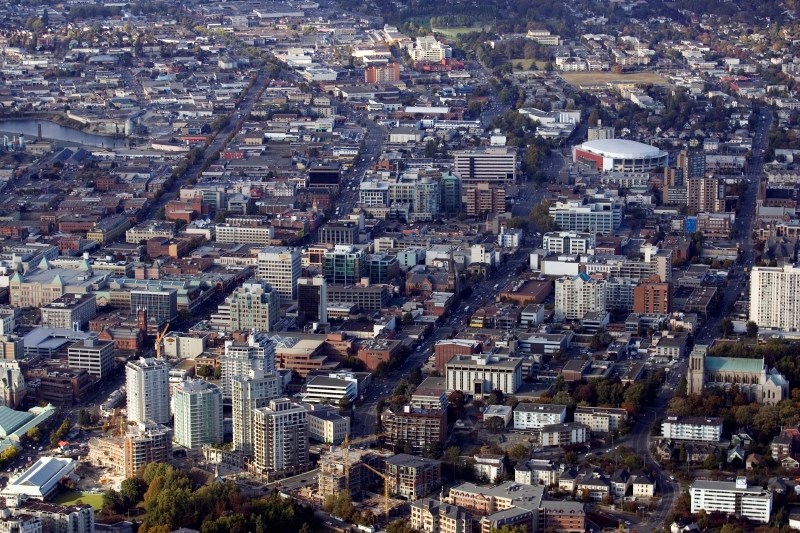Greater Victoria’s unemployment rate remained at 3.9 per cent in October, one of the lowest in the country, according to Statistics Canada’s monthly labour survey.
Greater Victoria has the second lowest unemployment rate behind only Guelph at 3.3 per cent. Quebec City is also at 3.9 per cent.
While the region’s labour force and total number of people employed was up slightly year-over-year, it did slip compared to September, when there were 197,100 people employed out of a labour pool of 205,100.
Last month, there were 195,400 employed of a labour pool of 203,200, said the national agency.
Labour force survey analyst Vincent Ferrao said Victoria saw a jump of 4,400 people in the construction sector last month compared with October 2017, as well as increases of 3,700 in the retail and wholesale trade sector and 2,200 more people working in the health care and social services.
Ferrao said there was a drop in the transportation and warehousing sector of 3,100 people year-over-year, and 2,000 fewer people employed in the accommodation and foodservices sector compared to the year previous.
Victoria had the lowest unemployment rate in B.C., ahead of Vancouver at 4.3 per cent, Abbotsford at 4.7 per cent and Kelowna at 5.0. For the 14th month in a row, B.C. had the lowest unemployment rate in the country at 4.1 per cent.
In the past year, employment in the province increased by 48,000, the vast majority in full-time jobs in the private sector.
Minister of Jobs, Trade and Technology Bruce Ralston said the numbers are a reflection of a strong economy. “After over a decade of stagnation in wage growth, people are now seeing the benefits of our strong economy. British Columbia had the third-highest growth among the provinces, and B.C. has been in the top two for wage growth for 11 of the past 12 months,” he said. “Strong job growth, low unemployment and good wages support a better quality of life for all British Columbians.”
Canada’s unemployment rate edged back down to its four-decade low of 5.8 per cent. But even in a job market that’s having a hard time finding workers, wage growth is continuing to slow.
The country added 11,200 net new jobs in October, including a gain of 33,900 full-time positions, Statistics Canada said Friday.
The agency said the jobless rate moved down from its 5.9 per cent reading in September, in large part because fewer people searched for work.
One fresh data point, in particular, is likely to catch the Bank of Canada’s attention: wage growth.
The indicator is watched by the central bank ahead of its interest-rate decisions and, despite the tightened labour market, pay growth slowed for its fifth-straight month. Solid wage growth can apply upward pressure on inflation, which can then feed into the Bank of Canada’s decisions on interest rates.
Year-over-year, average hourly wage growth slowed last month to 2.19 per cent for its weakest reading since September 2017. Experts have predicted wage growth to rise along with the tightened labour market, but average hourly wage growth has dropped every month since May when it was 3.94 per cent.
When it comes to permanent employees, wage growth last month rang in at just 1.9 per cent — which TD senior economist Brian DePratto noted is below inflation. “The wage rate definitely stands out here,” said DePratto, who believes the number will make it a little bit less likely the Bank of Canada will introduce another interest rate hike in December.
Unemployment rates
Canada
October employment (numbers from the previous month in parentheses):
- Unemployment rate — 5.8 per cent (5.9)
- Employment rate — 61.5 per cent (61.5)
- Participation rate — 65.2 per cent (65.4)
- Number unemployed — 1,141,700 (1,171,100)
- Number working — 18,705,000 (18,693,800)
- Youth (15-24 years) unemployment — 11.0 per cent (11.0)
- Men (25 plus) unemployment — 5.0 per cent (5.2)
- Women (25 plus) unemployment — 4.9 per cent (4.9)
Provinces
- Newfoundland/Labrador — 12.7 (13.6)
- Prince Edward Island — 7.2 (8.7)
- Nova Scotia — 7.7 (7.8)
- New Brunswick — 7.2 (7.9)
- Quebec — 5.2 (5.3)
- Ontario — 5.6 (5.9)
- Manitoba — 6.1 (5.8)
- Saskatchewan — 6.2 (6.4)
- Alberta — 7.3 (7.0)
- British Columbia — 4.1 (4.2)
Cities
- St. John’s, N.L. — 9.0 (9.6)
- Halifax — 6.6 (6.7)
- Moncton, N.B. — 5.8 (6.2)
- Saint John, N.B. — 6.0 (5.5)
- Saguenay, Que. — 5.7 (6.3)
- Quebec — 3.9 (3.8)
- Sherbrooke, Que. — 4.8 (4.3)
- Trois-Rivieres, Que. — 4.9 (4.6)
- Montreal — 5.9 (6.1)
- Gatineau, Que. — 4.4 (4.5)
- Ottawa — 4.7 (4.5)
- Kingston, Ont. — 5.4 (5.5)
- Peterborough, Ont. — 6.2 (5.6)
- Oshawa, Ont. — 5.8 (5.6)
- Toronto — 6.3 (6.1)
- Hamilton, Ont. — 5.0 (5.2)
- Kitchener-Waterloo, Ont. — 5.2 (5.1)
- Brantford, Ont. — 6.2 (5.8)
- Guelph, Ont. — 3.3 (3.6)
- London, Ont. — 4.9 (5.2)
- Windsor, Ont. — 6.9 (7.3)
- Barrie, Ont. — 5.2 (5.8)
- Sudbury, Ont. — 6.0 (6.4)
- Thunder Bay, Ont. — 5.3 (5.3)
- Winnipeg — 6.1 (6.2)
- Regina — 6.8 (6.4)
- Saskatoon — 6.9 (7.4)
- Calgary — 8.2 (8.2)
- Edmonton — 6.3 (6.3)
- Kelowna — 5.0 (5.7)
- Abbotsford — 4.7 (4.8)
- Vancouver — 4.3 (4.5)
- Victoria — 3.9 (3.9)



